Key Messages
At the LG Electronics press conference at CES 2018, company executives stressed that going forward, artificial intelligence (AI) will change the way we interact with products. Three things will be driving this.
The first is that these products will evolve over time as the AI algorithms will learn how you use the products, your preferences and more so that your interaction and patterns of behavior become known. This deep learning feature will mean you won’t have to command a product to do to something – it will sense your need and initiate it. The car will sense when you are drowsy and open a window or start the vacuum if you spill something.
Secondly, AI will move to everyday products in the home, office and on the road. Third, LG wants to develop open AI as it seeks to work with third party providers to get the best solutions that are also interoperable.
The company then introduced ThinQ, which is a branding term but also functions as a kind of AI operating system integrating internal and external third party voice and AI algorithms into products. LG is working with Google and Amazon now, but will add more partners later.
LG Electronics announced that all of its appliances and UHD TVs will add ThinQ AI in 2018 and it showed off its CLOI and other purpose-built robots, which did not behave very well in the live demo. (for a more detailed report on the LG conference see our main CES report)
New Technologies/Upgrades
LG Electronics added a number of new features and technologies that span many models of it high end OLED and Super Ultra HD TV lines. These include:
- New alpha 9 (A9) processor
- ThinQ AI processing
- 120 fps input frame rate support
- Voice integration with Google Home and Amazon Alexa
- Dolby Atmos Support
- Improved color processing
LG’s new A9 SoC processor advances on the current A7 processors with 35% more CPU and GPU power and 50% more DDR memory. This added horsepower enables some of the features including a quad-step noise-reduction algorithm and a better image-enhancement function with frequency-based sharpness, object-based contrast, and adaptive color (except in Cinema mode). For example, color remapping is now done with a 33x33x33 LUT, an upgrade from the 17x17x17 LUT in 2017 models. That should enable more precise remapping of colors that are outside of the native color gamut of the TV down to what can physically be displayed. The result: more accurate colors.

Also new is support for 120 fps input sources that can then be played back in their native frame rate. The new A9 processor can support playback any combination of resolution, frame rate and HDR. The A7 processor supports the same combination except 4K+HFR+HDR, as shown in the table below.
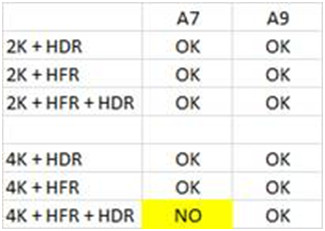
Currently, we don’t believe there is any real 120 fps content available in the market, although LG says some will arrive in 2018. Getting it into the TV may be an issue, however. A streaming source should work, says the company and content on a USB stick can work as well, they claim. However, none of the 2018 models have a HDMI 2.1 interface, which is needed for 4K/120 fps support. As a result, even if a 4k/120 Blu-ray disc was available, it could not playback on these LG TVs.
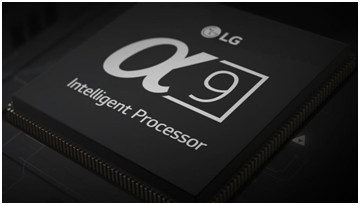
LG put a lot of emphasis on it new AI brand, ThinQ. This is apparently coupled with Google Assistant and Amazon’s Alexa so that the TV remote (which has a microphone) can be used for control. The integration with Google Home is more complete allowing voice commands to look for content – or even control other appliances and IoT devices from Google or Amazon partners. The ThinQ integration allows the user to skip the “Hey Google” command to get the attention of the processor – you simply say the command. Plus, it will integrate with your Google calendar, photos, etc. to provide access via the TV with Google Assistant. The Alexa integration won’t allow control of the TV whereas the Google integration will. LG also announced a new ThinQ speaker to couple with its TVs that works with Google Assistant and has technology from Meridian Audio inside.
HDR support is comprehensive with HDR10, HLG and Dolby Vision onboard for the 2018 models. As at CES 2017, LG says that they will add Advanced HDR by Technicolor as an additional HDR flavor later this year via a firmware upgrade – but I think they said the same thing a year ago. Not supported is HDR10+.
LG is also said to have added their own HDR mode they call “Cinema HDR.” This appears to be a kind of dynamic HDR mode that improves the picture quality of HDR10 and HLG content on a frame by frame basis. Their “HDR Effect” option is a way to turn SDR content into an HDR-like image.
OLED Canyon
LG Electronics has showcased their OLED tunnel for at least a year at major trade show, but at CES 2018, they installed a new design called the OLED Canyon that definitely wowed attendees. The company said, “The winding 92′ (28m) long LG OLED Canyon features 246 LG Open Frame OLED displays, in concave and convex configurations, giving tens of thousands of visitors a one-of-a-kind experience of natural wonders.”
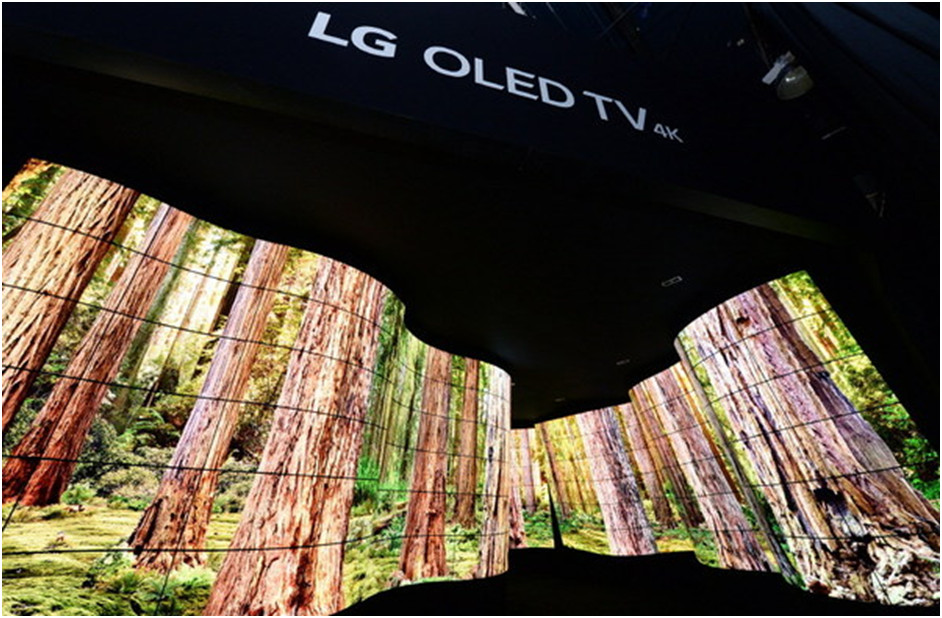
OLED TVs
LG continues its main lines of OLED TV models with W8, E8, C8 and B8 lines (plus a G8 line, but not for the U.S., apparently, where the G7 line will continue). The main features are summarized in the table.
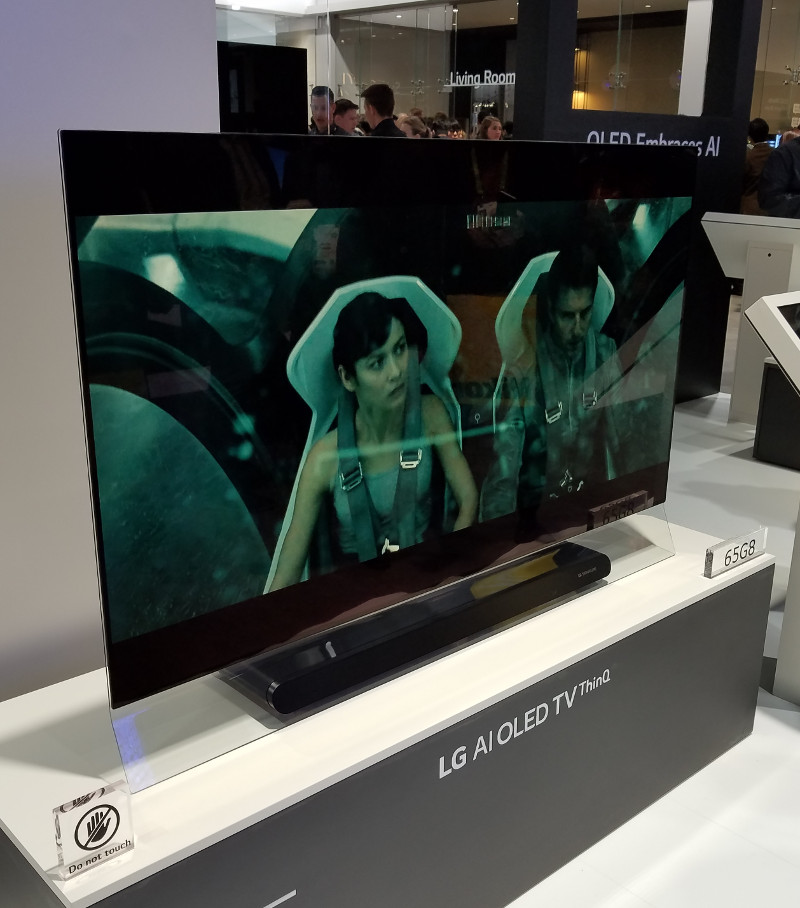
New is the addition of a 77” model to the C8 line, but otherwise the sizes and form factors remain similar, Only the C8, E8 and W8 lines get the new A9 processor, however, with the B8 retaining the A7 SoC. LG is not disclosing the luminance or color gamut of the 2018 models, but others we have talked to suggest that these specs remain essentially the same as last year.
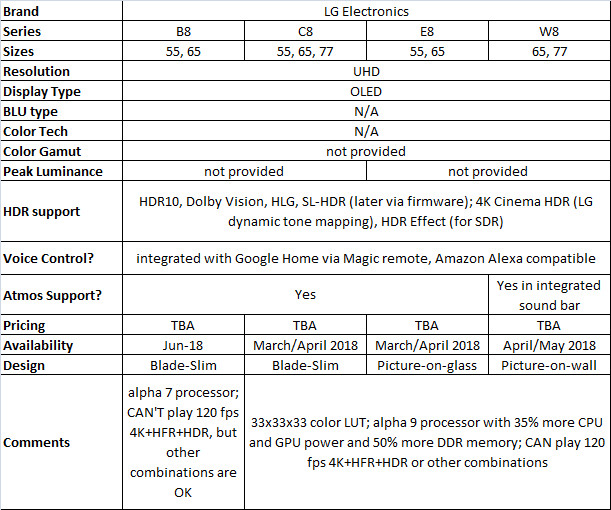
LCD TVs
The LCD model series are also similar to 2017 with the high end Super UHD TVs topped with the SK8000, SK8500 and SK9000 series. All continue the NanoCell technology introduced in 2017 models. This consists of nanometer scale particles that absorb yellow light to create more pure red and green primaries, allowing for a wider color gamut. The effect is similar to a quantum dot solution, but NanoCell particle absorb light whereas quantum dot materials emit light. The NanoCell technology is also said to reduce reflections by 44% as well (by apparently absorbing yellow light in the room).
LG also pointed out that the viewing colors can be maintained in their IPS panels to about 60º off-axis – very impressive indeed. LG claims that less than 20% of TV viewers routinely watch at 0°—that is, on axis—while close to 100% watch at up to 60° off axis at least some of the time. Those seem like odd statistics so we would need to see the source to be fully persuaded of this. The chart from the show floor summarizes the LCD technologies and advantages (Nanocell for WCG, consistent color performance over wide viewing angles, and lack of haloing with full array backlight dimming).
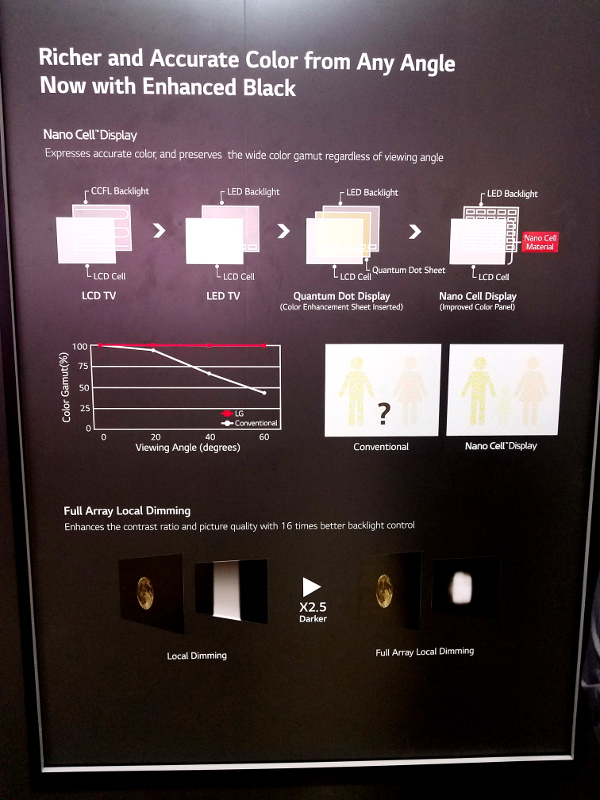
Like Samsung, LG has topped their line with FALD models to replace an all-edge lit line up from 2017. The LCD models retain the alpha 7 processor, not upgrading to the alpha 9. LG was not providing any details on peak luminance, black level or color gamut at CES.

Calibration
Third party calibration of LG UHD TV also is going to be a lot easier and more accurate thanks to a partnership with Portrait Displays and their CalMan software, developed by wholly-owned SpectraCal. New for 2018 OLED and SUPER UHD LCD models is an autocal feature that will much more precise tuning and calibration of the display – and save the calibrator a lot of time as well (from an hour to under 10 minutes). In fact, LG and Portrait claim the color accuracy will now rival professional color grading displays.
LG is the first manufacturer to allow CalMAN direct access to the underlying hardware look-up tables in the television. This allows for increased calibration flexibility and is not limited to the adjustment ranges of manual on screen calibration controls. They are also the first televisions to offer three-dimensional look-up tables (3D LUTs) as one of the CalMan accessible tables, allowing correction of minute color variances.
3D LUT correction has long been the “gold standard” for video accuracy among video industry professionals. “When you need a display to be extremely accurate, the usual solution is to add a 3D LUT box to the video chain,” said Portrait’s Technical Liaison Tyler Pruitt. “The 3D LUT box corrects minor non-linearities that the display’s controls alone won’t correct,” Pruitt explained. Image processors with 3D LUTs cost from hundreds to thousands of dollars, and are employed by home theater videophiles as well as studio industry professionals.
“With the 2018 LG premium televisions, the 3D LUTs are inside the television and available to CalMAN. This eliminates the need for an external LUT box,” Pruitt said.
The CalMAN AutoCal by SpectraCal capability on the 2018 LG TVs extends across the LG premium television product line, and is available not only for standard dynamic range (SDR) but also for all three varieties of high dynamic range (HDR): HDR10, HLG, and Dolby Vision.
At the SMPTE conference last October, Pruitt gave a more detailed presentation on how this new Auto Cal function works. The key, he explained, is a “by-pass” mode that lets the calibration software gain unfettered access to the native display mode – where a gamma (not PQ or HLG) EOTF is installed from the factory.
The issue is that all of the upstream HDR processing is done based on the “average” performance of the underlying TV display. But displays have manufacturing variances and these variances cannot be calibrated out using TV controls, which is also why even reference monitors need external 3D LUT boxes.
He pointed out an additional problem as well. For one, all HDR panels today still use gamma at the panel level so incoming content with an HDR EOTF (PQ or HLG-based) gets remapped to the native gamma of the panel at the end of the video processing chain. TV calibration controls were developed in the 709/SDR era and did not consider the need for EOTF-to-gamma conversion nor color volume remapping. These functions are done at the beginning of the video processing pipeline whereas the calibration controls are at the end of the pipeline. This can result in some strange behavior with these control knobs.
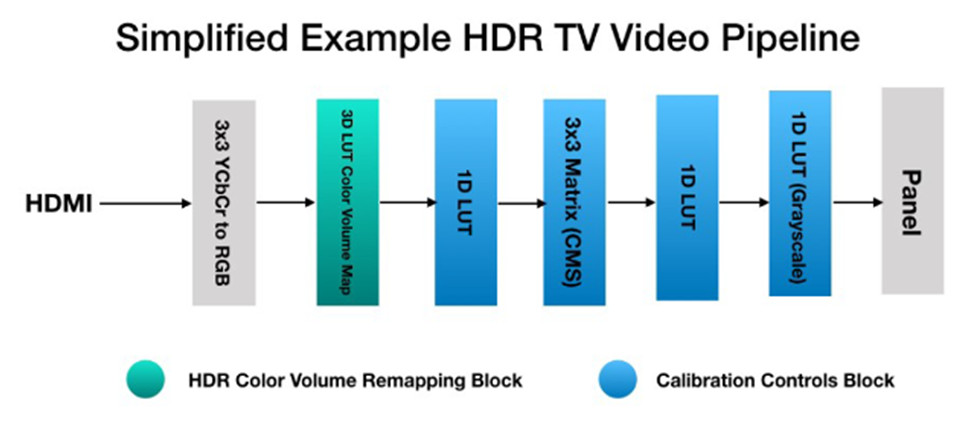
Because of these issues, Pruitt presented a new method for HDR TV calibration that is independent of HDR color volume remapping behavior, but it will require the cooperation of HDR TV makers to implement. The idea is to calibrate the HDR picture mode(s) with all color volume remapping and EOTF-to-gamma conversion disabled or bypassed. This will allow calibration of the display’s grayscale and gamma response to occur without fighting against these proprietary HDR remapping/conversion algorithms. Once the HDR television is in the HDR bypass mode, the display can be calibrated using the normal grayscale, gamma, or white balance controls in the display’s OSD menu system.
The second part of this proposed calibration process for consumer HDR display devices is to measure a “Color Volume Profile.” By measuring the actual color volume performance of the display device, those values can be fed back into the beginning of the video processing pipeline. The display can then use its actual measured performance to more accurately perform the color volume remapping of the HDR content.
The Color Volume Profile will consist of measured values of the following metrics. (These measurements should be made while the display device is still in the HDR bypass mode from the previous step.)
- Peak Luminance of White (cd/m²)
- Black Level (cd/m²)
- Red Primary (CIE1931 xy)
- Green Primary (CIE1931 xy)
- Blue Primary (CIE1931 xy)
ATSC 3.0
LG Electronics has been heavily involved in the development of the ATSC 3.0 over-the-air next generation standard, which was finalized and approved by the FCC prior to CES 2018. At CES, the company revealed that their 2017 and 2018 TV models already have tuners built in that will decode ATSC 3.0 signals. They also announced plans to support trials in Korea and in the U.S. in 2018.
Korea adopted the Next Gen TV standard in 2017 and leading broadcasters KBS, MBC and SBS launched ATSC 3.0 broadcasting in advance of 4K UHD transmission of next month’s 2018 Winter Games in Pyeongchang.
Automation Integration
LG Electronics also said its 2018 LG OLED and LG SUPER UHD TVs will feature Control4 Simple Device Discovery Protocol (SDDP) technology. The integration enables LG to offer automation-ready televisions for consumers worldwide.
Control4 Corporation is a leading provider of automation and control solutions for the connected home. Products like flat-panel TVs, projectors, audio/video receivers, security cameras, alarm panels, and other network-aware products can be easily integrated into consumers’ smart and connected homes via Control4 technology. With SDDP, the Control4 home automation system automatically finds, identifies, authenticates, adds and connects the SDDP-enabled devices nearly instantaneously during initial installation and set-up – dramatically reducing the complexity and configuration time for Control4 installers, and reducing potential incompatibility with other devices.

